20+ Bid Form Examples to Download
A bid form presents all the required and important information on the bidding project. It is also the criteria by which we can compare the different bidders and aid in taking a quick and accurate decision as to who should get the project. A bid form is generated by a company to be filled up and submitted to the company.
The bid form is usually submitted as a reply for a bid invitation generated by the company. Given here are 20+ bid forms examples and templates for you to refer to.
Bid Form Examples & Templates
1. Painting Bid Form Example
Painting and wall coverings are an indispensible part of any interior decoration be it home or commercial area and this bid form informs can be used by the reader as the necessary criteria that needs to be fulfilled are mentioned here clearly.
2. Bid Tabulation Form Sample
This is a template of a certified tabulation form for bids that are to be called for a particular project with the right design and one can use the format to create one.
3. Bid Bond Form Example
This bid form has been designed and formulated in such a way so that it can be used as a guarantee in connection to construction works, any work requiring alter and repair of something and is a classic example of a bid form of a newly formed corporation.
4. Form Example for Bid Security
Bank guarantee in the form of a form confirming bid security is required by the bidder so that the financial confirmation made by the bidder can be made full proof.
5. Bid Proposal Form Sample
This is a bid proposal which is an informal one made by the transport department of New Jersey for a painting project of a garage and the details can be used by the bidder for a similar bid.
6. Bid for Construction Contracts Form
This example has an additional feature because it contains a checklist from the labour standards division following the labour law clauses that the bidder has to abide while bidding for the job and also the bond that it has to keep for bidding in a construction project.
7. Telephone Bid Form Sample
Auction houses call the bids where the bidder can bid through telephone and this is a template of such bidding along with the conditions for selling the item to the bidder.
8. Job Bid Form Example
The schools often call for bids to fill different positions and this bid form is one such template that will be useful for a bidder applying for the bid.
9. Bid Summary Form Sample
The finance division of a university has used this summary bid form along with a checklist for purchase to abide with the university’s policy for purchase and FAR rules.
10. Sample Bid Form Example
The bidder of a project based on way finding signs is giving a written undertaking that he will submit all the documents required to be furnished in the bid, and that he will abide with all the terms, conditions, rules, and regulations mentioned in the bidding documents to the full if he gets the project.
11. Real Estate Sealed Bid Form
This is an example of a bid form used in an auction house for real estate sell which the bidder should fill up following the terms and conditions of the bid which will be helpful to format a similar document for bidding by other real estate farms.
12. Bid Form in PDF
The document format of this bid form is for a bit for funding whereby the bidders are agreeing work in accord with the bidding terms and conditions and this has been done in a very point wise manner adding clarity to the whole agreement which even a layman could understand.
13. Basic Bid Form Example
This bid form is formatted on the terms and conditions for sale of assets in a bank auction where all the bidder details have been taken into account along with his written declaration for his abidance to the bank rules and regulations.
14. Printable Bid Form in PDF
This is a very user friendly printable bid form for the bidder who is giving a written consent to following and executing the project fulfilling every condition mentioned in the bid.
15. Registration Bid Form Template
Bids that take place in the absence of the bidder through telephone or otherwise, can use this bid form format where the terms and conditions have also been put in to make it a perfect one to meet the purpose.
16. Professional Bid Form Example
This format for bid form along with an envelope has been provided by a company managing ocean energy for the bidders’ convenience so that the bid format is perfect for the new bidder.
17. Metro Absentee Bid Form
A consent bid form is given here as an example which can be used by the bidder who is giving a consent to an auction house to bid on his behalf following the terms and conditions of the consenter.
18. Contractor Bid Form Example
This is an example of a contractors’ bid form for public works projects in the prescribed format designed by the accounts department of the State Board and can be used for all types of bidding of the abovementioned type.
19. Tender Bid Form Sample
The Australian Consulate has put up a tender to sell some commodities and this is the bidders’ application for bidding that can be used by the new bidders as a written consent form following the conditions put up by the concerned authority to bid.
20. Real Property Bid Form Template
This template, which can be printed, is a bid form for the bidder to purchase real property and can be used as a ready format for bidding maintaining the terms and conditions put forward by the seller.
21. Printable Bid Form Example
A specific bid form format has been given here as an example to be used by those clubs and organisations who wants to bid in a bidding put up by the Universities to meet up its different expenditures.
20+ Bid Form Examples to Download

A bid form presents all the required and important information on the bidding project. It is also the criteria by which we can compare the different bidders and aid in taking a quick and accurate decision as to who should get the project. A bid form is generated by a company to be filled up and submitted to the company.
The bid form is usually submitted as a reply for a bid invitation generated by the company. Given here are 20+ bid forms examples and templates for you to refer to.
Bid Form Examples & Templates
1. Painting Bid Form Example
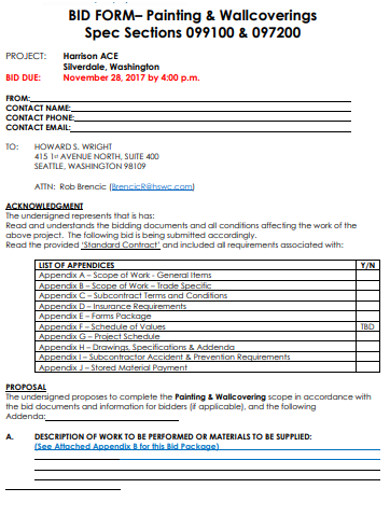
kitsapeda.org
Details
File Format
PDF
Size: 163 KB
Painting and wall coverings are an indispensible part of any interior decoration be it home or commercial area and this bid form informs can be used by the reader as the necessary criteria that needs to be fulfilled are mentioned here clearly.
2. Bid Tabulation Form Sample
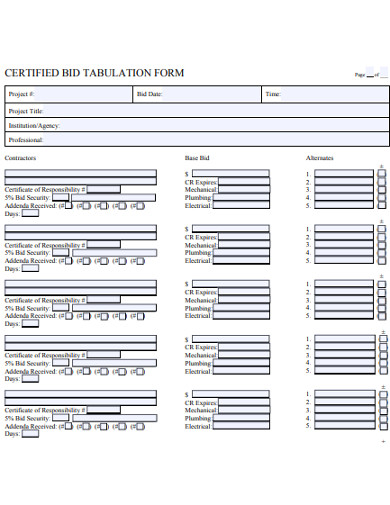
dfa.ms.gov
Details
File Format
PDF
Size: 76 KB
This is a template of a certified tabulation form for bids that are to be called for a particular project with the right design and one can use the format to create one.
3. Bid Bond Form Example

dgs.dc.gov
Details
File Format
PDF
Size: 29 KB
This bid form has been designed and formulated in such a way so that it can be used as a guarantee in connection to construction works, any work requiring alter and repair of something and is a classic example of a bid form of a newly formed corporation.
4. Form Example for Bid Security
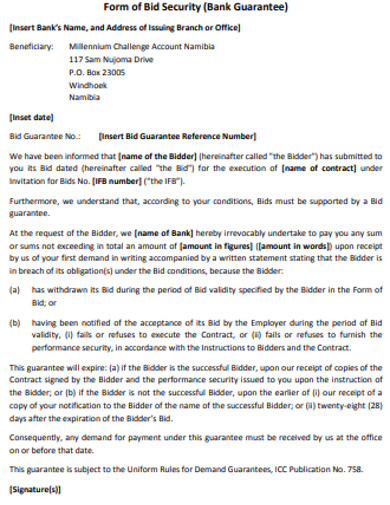
mcanamibia.org
Details
File Format
PDF
Size: 246 KB
Bank guarantee in the form of a form confirming bid security is required by the bidder so that the financial confirmation made by the bidder can be made full proof.
5. Bid Proposal Form Sample
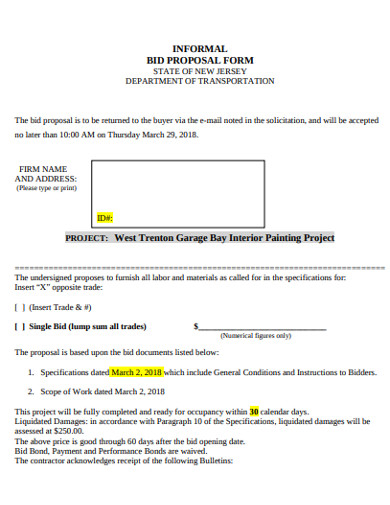
nj.gov
Details
File Format
PDF
Size: 79 KB
This is a bid proposal which is an informal one made by the transport department of New Jersey for a painting project of a garage and the details can be used by the bidder for a similar bid.
6. Bid for Construction Contracts Form
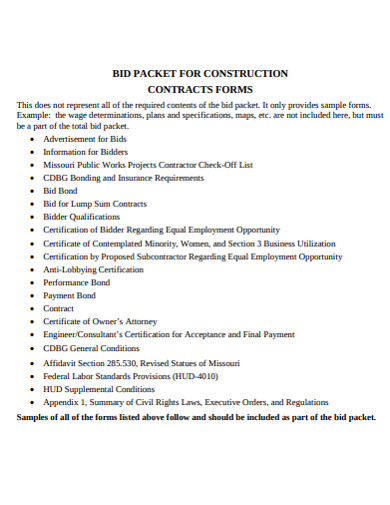
ded.mo.gov
Details
File Format
PDF
Size: 3 MB
This example has an additional feature because it contains a checklist from the labour standards division following the labour law clauses that the bidder has to abide while bidding for the job and also the bond that it has to keep for bidding in a construction project.
7. Telephone Bid Form Sample
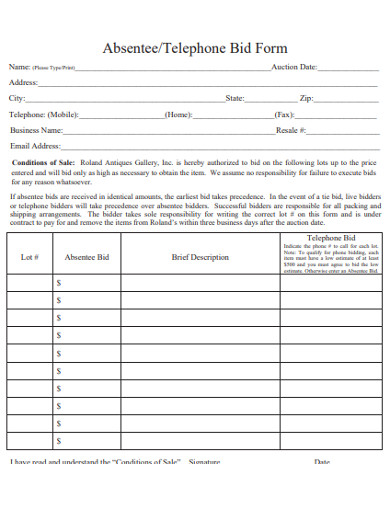
static1.squarespace.com
Details
File Format
PDF
Size: 387 KB
Auction houses call the bids where the bidder can bid through telephone and this is a template of such bidding along with the conditions for selling the item to the bidder.
8. Job Bid Form Example
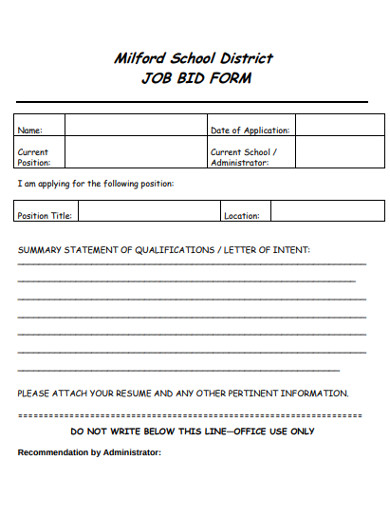
milfordk12.org
Details
File Format
PDF
Size: 40 KB
The schools often call for bids to fill different positions and this bid form is one such template that will be useful for a bidder applying for the bid.
9. Bid Summary Form Sample
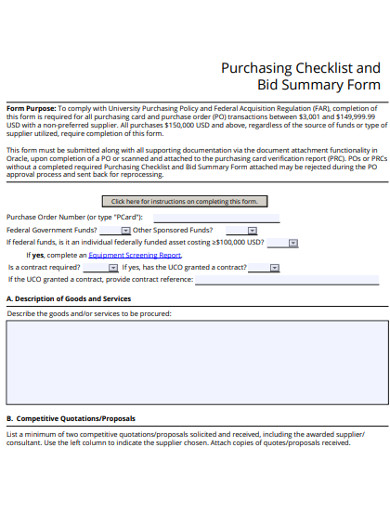
cmu.edu
Details
File Format
PDF
Size: 280 KB
The finance division of a university has used this summary bid form along with a checklist for purchase to abide with the university’s policy for purchase and FAR rules.
10. Sample Bid Form Example
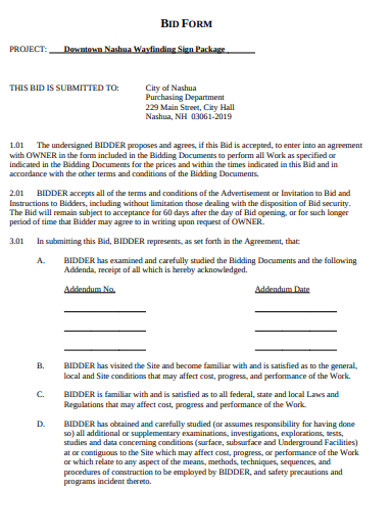
nashuanh.gov
Details
File Format
PDF
Size: 65 KB
The bidder of a project based on way finding signs is giving a written undertaking that he will submit all the documents required to be furnished in the bid, and that he will abide with all the terms, conditions, rules, and regulations mentioned in the bidding documents to the full if he gets the project.
11. Real Estate Sealed Bid Form
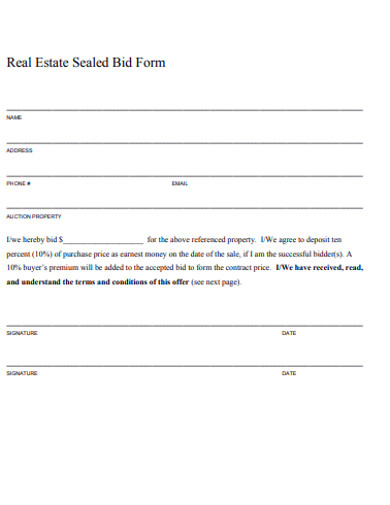
s3.amazonaws.com
Details
File Format
PDF
Size: 168 KB
This is an example of a bid form used in an auction house for real estate sell which the bidder should fill up following the terms and conditions of the bid which will be helpful to format a similar document for bidding by other real estate farms.
12. Bid Form in PDF
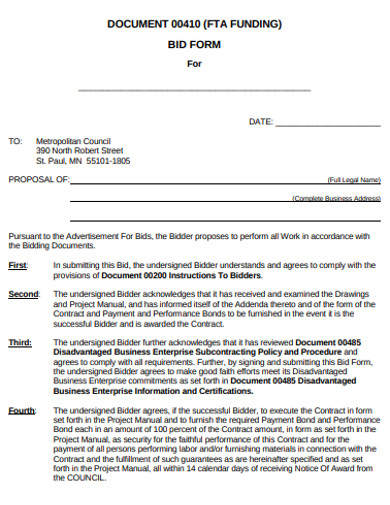
metrocouncil.org
Details
File Format
PDF
Size: 26 KB
The document format of this bid form is for a bit for funding whereby the bidders are agreeing work in accord with the bidding terms and conditions and this has been done in a very point wise manner adding clarity to the whole agreement which even a layman could understand.
13. Basic Bid Form Example
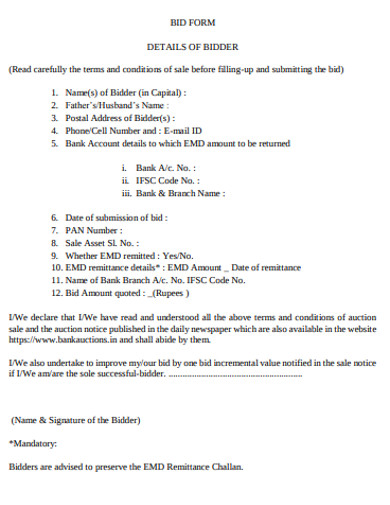
vinodkothari.com
Details
File Format
PDF
Size: 149 KB
This bid form is formatted on the terms and conditions for sale of assets in a bank auction where all the bidder details have been taken into account along with his written declaration for his abidance to the bank rules and regulations.
14. Printable Bid Form in PDF
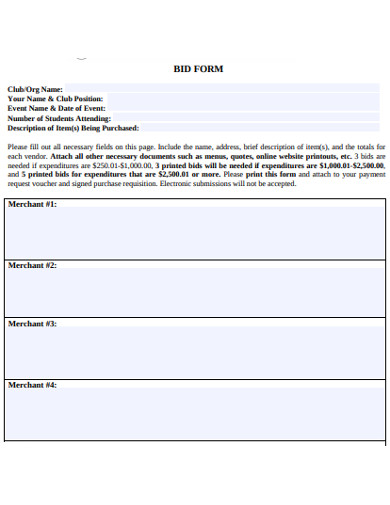
agcqc.org
Details
File Format
PDF
Size: 59 KB
This is a very user friendly printable bid form for the bidder who is giving a written consent to following and executing the project fulfilling every condition mentioned in the bid.
15. Registration Bid Form Template
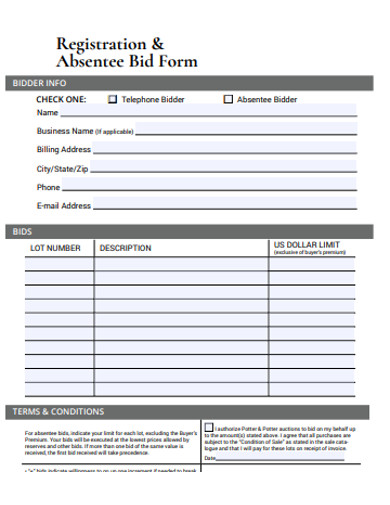
potterauctions.com
Details
File Format
PDF
Size: 199 KB
Bids that take place in the absence of the bidder through telephone or otherwise, can use this bid form format where the terms and conditions have also been put in to make it a perfect one to meet the purpose.
16. Professional Bid Form Example
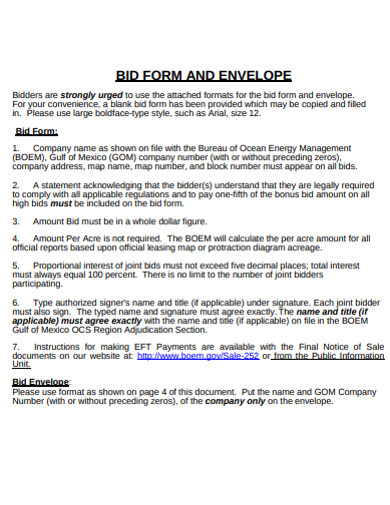
boem.gov
Details
File Format
PDF
Size: 51 KB
This format for bid form along with an envelope has been provided by a company managing ocean energy for the bidders’ convenience so that the bid format is perfect for the new bidder.
17. Metro Absentee Bid Form
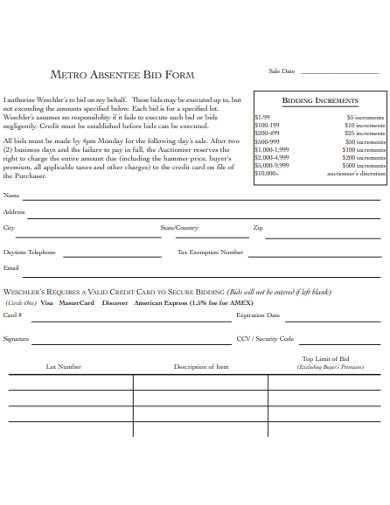
weschlers.com
Details
File Format
PDF
Size: 208 KB
A consent bid form is given here as an example which can be used by the bidder who is giving a consent to an auction house to bid on his behalf following the terms and conditions of the consenter.
18. Contractor Bid Form Example
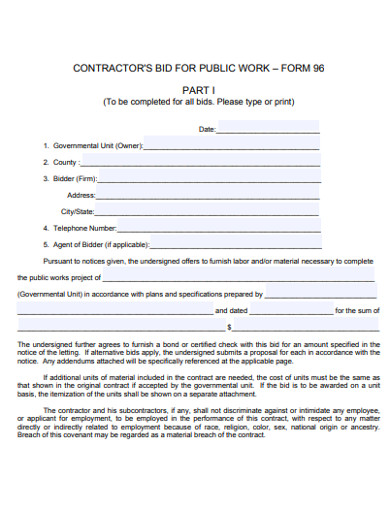
in.gov
Details
File Format
PDF
Size: 50 KB
This is an example of a contractors’ bid form for public works projects in the prescribed format designed by the accounts department of the State Board and can be used for all types of bidding of the abovementioned type.
19. Tender Bid Form Sample
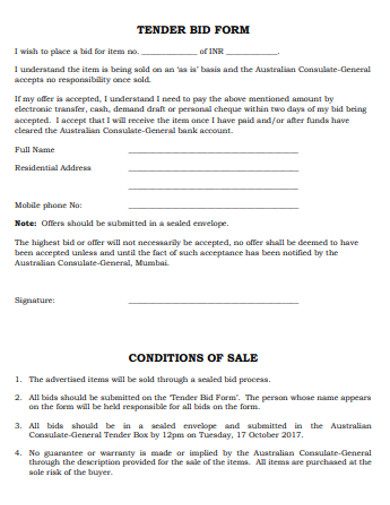
mumbai.consulate.gov.au
Details
File Format
PDF
Size: 50 KB
The Australian Consulate has put up a tender to sell some commodities and this is the bidders’ application for bidding that can be used by the new bidders as a written consent form following the conditions put up by the concerned authority to bid.
20. Real Property Bid Form Template

hss.sbcounty.gov
File Format
PDF
Size: 418 KB
This template, which can be printed, is a bid form for the bidder to purchase real property and can be used as a ready format for bidding maintaining the terms and conditions put forward by the seller.
21. Printable Bid Form Example
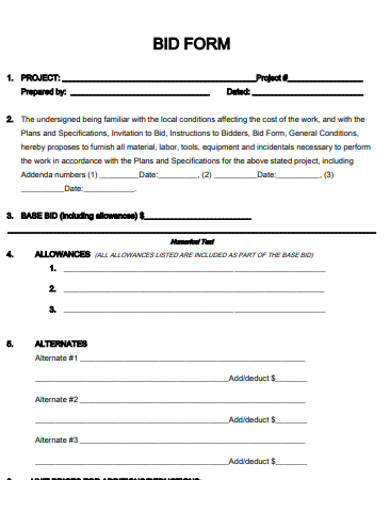
baruch.cuny.edu
Details
File Format
PDF
Size: 94 KB
A specific bid form format has been given here as an example to be used by those clubs and organisations who wants to bid in a bidding put up by the Universities to meet up its different expenditures.

